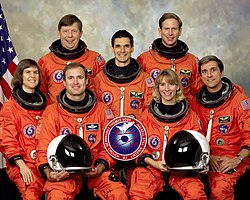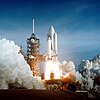STS-83
| Mission emblem | |||
|---|---|---|---|

|
|||
| Mission dates | |||
| Mission: | STS-83 | ||
| COSPAR-ID : | 1997-013A | ||
| Begin: | April 4, 1997, 19:20:32 UTC | ||
| Starting place: | Kennedy Space Center , LC-39A | ||
| Landing: | April 8, 1997, 18:33:11 UTC | ||
| Landing place: | Kennedy Space Center, Lane 15 | ||
| Flight duration: | 3d 23h 13min 38s | ||
| Earth orbits: | 63 | ||
| Rotation time : | 90.5 min | ||
| Orbit inclination : | 28.4 ° | ||
| Apogee : | 303 km | ||
| Perigee : | 298 km | ||
| Covered track: | 2.4 million km | ||
| Team photo | |||
 v. l. No. Front: James Halsell, Susan Leigh Still-Kilrain; Middle: Janice Voss, Greg Linteris, Donald Thomas; Back: Roger Crouch, Michael Gernhardt |
|||
| ◄ Before / After ► | |||
|
|||
STS-83 ( English S pace T ransportation S ystem) is a mission name for the US space shuttle Columbia ( OV -102) of NASA . The launch took place on April 4, 1997. It was the 83rd space shuttle mission and the 22nd flight of Columbia.
team
- James Halsell (3rd space flight), commander
- Susan Still-Kilrain (1st spaceflight), pilot
- Janice Voss (3rd space flight), mission specialist
- Donald Thomas (3rd spaceflight), mission specialist
- Michael Gernhardt (2nd space flight), mission specialist
- Roger Crouch (1st Spaceflight), Payload Specialist , NASA Microgravity Space and Applications Division
- Gregory Linteris (1st Spaceflight), Payload Specialist, National Institute of Standards and Technology
This crew holds the record for the shortest time span between two missions (83 days between STS-83 and STS-94 ).
replacement
- Catherine Coleman for Thomas, who broke his ankle two months before take-off but recovered quickly enough to be able to take the flight
- Paul Ronney for Crouch and Linteris
Mission overview
The mission was originally scheduled to last 15 days and 16 hours, but had to be shortened because a problem arose in a Columbia fuel cell . Therefore, the orbiter landed back on earth after just three days and 23 hours. NASA decided to fly the mission again as STS-94 three months later.
STS-83 carried the so-called Microgravity Science Laboratory (MSL) as a payload. 33 investigations were planned, 19 of them of a material science nature. After the start of the Spacelab , the high-packed digital video was activated, with which several analog television channels were bundled, which allowed the transmission of several video signals simultaneously. Then experiments began to grow protein crystals (over 1500) of the highest purity. The spatial structure of these proteins is to be examined in detail on earth using them. This is mainly used for medicine. There are more than 300,000 different proteins in the human body, which is why this experiment was part of most of the shuttle missions.
In addition to the material science experiments, the measurement of the residual accelerations on board the space shuttle attracted a lot of attention. Due to the movement of the space travelers, small forces are constantly acting on the space shuttle, which briefly disturb the weightlessness. Four apparatus were used for these investigations. All were activated on the first day of flight. Further experiments concerned the supercooling and rapid crystallization of metals and metal alloys, the diffusion of liquid metals and the mixing of liquid metals in a solid body (sintering experiment) in a large isothermal furnace.
In addition, combustion processes of liquids in the form of drops were researched. This involved internal currents, flame shapes, temperature distributions, carbon monoxide emissions and processes that cause flames to go out. To do this, air pressure, oxygen concentration and drop size were varied (2 - 5 mm). The formation and stability of fireballs was also examined. The knowledge gained from this should be used to increase the efficiency of combustion processes in car engines. It is also hoped that progress will be made in the development of new fire fighting methods. With an electromagnetic heating system, thermophysical properties of supercooled liquids were investigated. It is possible to investigate processes that are masked by gravitational effects on earth.
Two experiments were carried out in an EXPRESS rack. First, the physics of curved surfaces was examined. On the third day of the flight, this apparatus was replaced by a system for researching plant growth in weightlessness. EXPRESS is a double cabinet in which experiments for various tasks are automatically activated and controlled. The module was later to be used in the International Space Station ISS.
Another technical test was the use of a glove box in the middle deck of the Columbia. The contactless change in position of floating drops of liquid was tested here. Without the influence of mechanical instruments, bubbles and drops can only be properly examined.
For the third time in the history of the space shuttle, a mission has been shortened. The Columbia was supplied with sufficient energy by two fuel cells, but the experiments should have been restricted. In addition, the failure of another fuel cell could have made a correct landing impossible. Therefore, the space shuttle landed on April 8 at the Kennedy Space Center in Florida.
On this mission, the pilot Susan Still took Kara Hultgreen's pilot needle into space, who also wanted to become an astronaut and who had a fatal accident with her F-14 Tomcat in October 1994 while approaching the aircraft carrier USS Abraham Lincoln .
See also
Web links
- NASA mission summary (English)
- Video summary with comments of the crew (English)
- NASA video of Mission (English)
